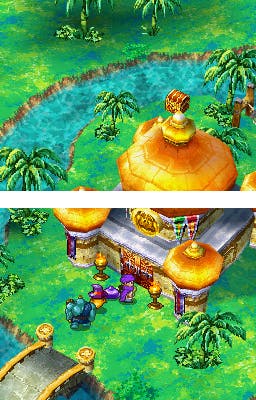Dragon Quest V: Hand of the Heavenly Bride
Married in the Morning.
With sales approaching 1.3 million units, this handheld remake of Dragon Quest V was the third best-selling Nintendo DS title in Japan last year, and the seventh highest-selling videogame on any system in the country. For the Japanese, this game represents one of the most significant remakes in recent years, so great is the sense of nostalgia and reverence the nation holds for its most-beloved RPG series.
But outside of its native home, Dragon Quest V doesn't have the same cultural cachet. No national holidays have been proclaimed in its name and its release this week will be met without much fanfare or expectation. It's not surprising. Neither the Super Famicom original nor the PlayStation 2 update of this game have been seen outside of Japan, so there isn't any latent sentimentality for Square Enix to bank or draw on.
But to ignore Dragon Quest V is to overlook a significant link in the medium's chain of development: a title whose monster-hunting core directly begat Pokémon, and whose fairytale story is one of the RPG genre's most compelling, even if it is also one of its most straightforward. The game tells the vivid tale of a man's progression through life from the moment of his mysterious birth, through boyhood and adolescence, right up to the point at which he chooses a bride and starts his own family.
Along the way there is heartbreak and tragedy, laughter and love. Each chapter of the game focuses on a different stage of your hero's life, and each one brings with it a different social problem that needs solving while offering more clues to the overarching quest: the search for an identity and the truth of your character's origins.

The story is down-to-earth, closer to an unfussy fairytale than a grand Tolkien epic, but it certainly dances with cliché at numerous points along the way. There are no sub-plots to speak of, just a linear story that moves from A to B to C to Denouement. As ever, this lack of narrative complexity is offset by the winning charm of Yujii Hori's storytelling and, thanks to some gentle twists on convention, the quest remains compelling over its relatively brief 20-odd hours.
Visually, the game combines 3D backgrounds with 2D sprites, the same aesthetic employed by its predecessor, Chapters of the Chosen. The option to rotate the camera 360 degrees around most environments allows for some mild exploration puzzles, but generally the new look simply freshens the world while retaining its Super Famicom soul.
The 16-bit feel of the game is added to by a deft new translation from Square Enix, which employs a slew of dialects and accents to give its population diversity and contour. The dialogue, while understated, enjoys a clarity of expression and personality that's typical of Square Enix's redoubled efforts in this area of late. The option to converse with party members at any point, drawing comments from them concerning every single person you meet in the game, reveals the gigantic amount of translation work that's gone into the product. Its unflinching quality is laudable.
This DS version of the game is based on the PlayStation 2 remake, for which developer ArtePiazza tidied up the game's balance by removing some of the more powerful items and upping the party roster to four. Nevertheless, this is still an easy game that most players will breeze through. As with all Dragon Quest titles, there is no Game Over as such. If your party is wiped out in battle they will be returned to the nearest church save point, all of their experience points intact but with half of their money removed. The lack of any skill system (characters learn new spells and abilities when they level up, but you have no say over their development tree) means that character progression merely follows predetermined lines, player choice reduced to selecting which character they want to develop rather than the nature of that development.

Contemporary gamers may baulk at the random battles, but setting the message speed to 'fast' ensures that most skirmishes are over quickly. There is some strategy required for key boss fights, but on the whole you'll be able to blast through the majority of the game's battles, healing via spells or potions as required. The primary innovation rests, then, in the monster-collecting portion of the game, a feature that has gone on to inspire a whole sub-genre of Gotta-Catch-'Em-Alls. Almost every monster in the game can be recruited into your party and levelled up into something of a powerhouse, a design that makes up for the lack of customization in most of the game's other systems.
However, there is no escaping the fact that Dragon Quest V is a product of a simpler time. There is little profundity or complexity to be found either in the game's story or its mechanics, and players looking for pointers as to where the Japanese RPG might be headed in the future will find no answers here: all of the game's ideas and innovations have already been evolved by titles now well-established themselves.
But what remains here, seventeen years after its first release, is a game that's confident within its boundaries, an experience whose strength lies in its childlike (though not necessarily childish) approach. It's a game that boasts an indisputable wider significance - but today, it's worthwhile primarily because it's a joyfully innocent fable, albeit one whose impact lies in the telling more than in the tale.

